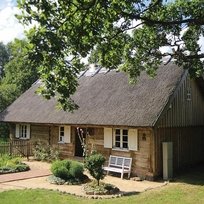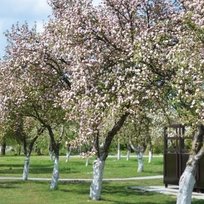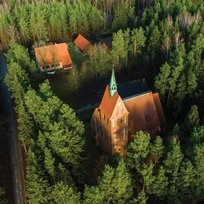Agluonėnai is a former village typical of Lithuania Minor. The village, situated on the bank of the Agluona Stream, was first mentioned in 1540.
In 1988, after the construction of a dam on the bank of the Agluona Stream, the creation of the Agluonėnai Park – a rural recreational area – started. In 1989, the Lietuvininkai Oak Grove was planted, and the monument-altar depicting the Columns of the Gediminids (sculptor: Justinas Mickevičius) was erected on the specially filled hill to mark the 450th anniversary of the Agluonėnai settlement and the national rebirth of Lithuania. In 2009, during the commemoration of the State Day, a monument (artists: J. Čepas and Klaipėda region artists) was unveiled in the Lietuvininkai Oak Grove in memory and legacy of Lithuania Minor's residents, the Lietuvininkai. The monument consists of an arch and a funerary sculpture (Lith. krikštas, the term for an original sculptural structure on tombs in Lithuania Minor) in the shape of an oak leaf. During en plein air held in the same year, more christenings were created to commemorate the most prominent figures of Lithuania Minor: R. Kant, K. Donelaitis, M. Mažvydas, L. Rėza, Vydūnas and I. Simonaitytė. The Agluonėnai Park also hosts other celebrations, such as St. John’s Day, national holidays and other events, during which the altar is lit and folk songs are performed by the Agluona Folklore Ensemble.
At the approaches to the Agluonėnai Park, you can see the country’s first and longest dam passage for salmon, constructed in 1988.
The mill of Jonas Genys, which stood in the village of Kantvainai within the Agluonėnai Eldership, was included in the list of technical monuments in the Soviet years. It was disassembled in 1979 to be removed to the Rumšiškės Open-air Folk Museum; however, it was never actually installed there. In 2001, the remaining parts of the mill were brought back to Agluonėnai by an initiative group formed by locals and are currently exhibited in the Agluonėnai Park.
Rural tourism is widely developed in the eldership. The homestead of P. and V. Račkauskai, offering sauna, accommodation and catering services, is known not only in the area but also far beyond its borders.
Since the beginning of the 1990s, Agluonėnai has developed a beautiful tradition of preserving the history and culture of Lithuania Minor and the Klaipėda region. In 1983, an ethnographic Lietuvininkai homestead museum was opened, and the first post-war barn theatre in Lithuania was established in the former homestead of M. Vytienė, which the collective farm bought from her descendants. The ethnographic homestead museum is included in the local register of cultural heritage objects and forms a branch of the Gargždai Regional Museum. The homestead is one of the preserved examples of the wooden architecture of Lithuania Manor, a typical homestead of farmers (Lith. laukininkai) owning a small farm (up to 10 hectares) in the Klaipėda region. In the restored homestead, efforts have been made to maintain the architectural style characteristic of the Klaipėda region, while the museum exhibits the household items and agricultural implements of the local residents, known as Lietuvininkai. An exhibition hall was installed in the outbuilding (barn) of the ethnographic homestead in 2000, hosting various exhibitions and expositions, as well as educational activities for students.






Reviews